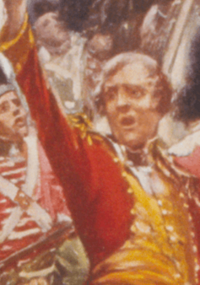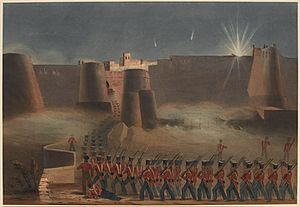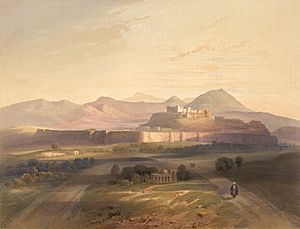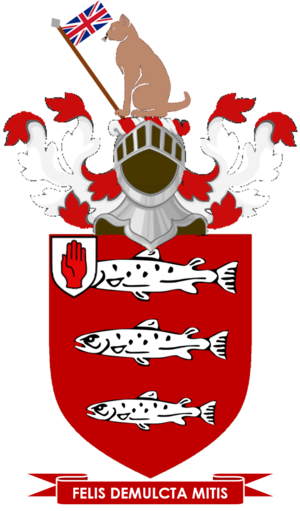John Keane, 1st Baron Keane facts for kids
Quick facts for kids
The Lord Keane
GCB GCH
|
|
|---|---|
 |
|
| Born | 6 February 1781 Waterford, County Waterford, Ireland |
| Died | 24 August 1844 (aged 63) Burton Lodge, Hampshire, England |
| Allegiance | United Kingdom |
| Service/ |
British Army |
| Years of service | 1794–1844 |
| Rank | Lieutenant-General |
| Commands held | Brigade, 3rd Division 5th Battalion, 60th Regiment of Foot Brigade, 3rd Division 8th Brigade, 5th Division 9th Brigade, AOOF Governor of Saint Lucia British Forces Jamaica Lieutenant-Governor of Jamaica Bombay Army Army of the Indus |
| Battles/wars |
|
| Awards | Knight Grand Cross of the Order of the Bath Knight Grand Cross of the Royal Guelphic Order |
| Relations | Sir John Keane, 1st Baronet (father) Edward Keane (brother) |
John Keane, 1st Baron Keane (born February 6, 1781 – died August 24, 1844) was an Irish soldier. He became a Lieutenant-General in the British Army. His bravery in the First Anglo-Afghan War led to him being made a Baron, which is a type of noble title. He was known as Baron Keane of Ghuznee.
Contents
Early Life and Family Background
John Keane was born in Waterford, Ireland, on February 6, 1781. He was the second son of John Keane of Cappoquin. His father later received the title of Baronet in 1801. John had an older brother, Richard, and a younger brother, Edward, who also became a soldier.
Military Career and Key Battles
John Keane had a long and important career in the British Army. He fought in several major wars.
Starting His Army Journey: French Revolutionary Wars
John Keane likely joined the British Army on October 11, 1794. He started as an ensign, which was the lowest officer rank. He was quickly promoted to lieutenant and then to captain. These early promotions were probably bought by his father, which was common then.
In 1799, Keane joined the 44th Regiment of Foot in Gibraltar. He then went to Egypt as an aide de camp (a personal assistant to a senior officer). He fought in the Egypt campaign. This included the Battle of Mandora and the Battle of Alexandria in 1801. After the French surrendered in Egypt, Keane moved to Malta. He was promoted to major in 1802 and then to lieutenant-colonel in 1803.
Fighting Napoleon: Napoleonic Wars
In 1808, Keane and his regiment, the 13th, joined the West Indies campaign. They helped capture Martinique in 1809. Keane was promoted to brevet colonel in 1812.
Later that year, he joined the Peninsular War in Spain. He commanded a brigade (a large group of soldiers) in the 3rd Division. Keane led his troops in several important battles:
- Battle of Vitoria (June 21, 1813)
- Battle of Sorauren (July 28 and 30, 1813)
- Battle of Nivelle (November 9, 1813)
- Battle of Orthes (February 27, 1814)
- Battle of Toulouse (April 10, 1814)
After the war in Europe ended, Keane was promoted to major-general on June 4, 1814.
The War of 1812 and Beyond
Keane was sent to Jamaica with more troops for the War of 1812 against the United States. He took command of the British forces there. He led them to the Mississippi River in December 1814.
At the famous Battle of New Orleans on January 8, 1815, Keane commanded the left attack. He was badly wounded in his groin. Luckily, his thick trousers saved him from a more serious injury. He recovered quickly and was present at the capture of Fort Bowyer in February. The war ended soon after. For his service, Keane was made a Knight Commander of the Order of the Bath.
After returning to Europe, Keane missed the Battle of Waterloo. However, he was given command of the 8th Brigade in the army that occupied France. He continued to serve until his command was dissolved in 1817.
Leadership in India: Bombay Army
In 1818, Keane became the Governor of Saint Lucia, an island in the Caribbean. From 1823 to 1829, he commanded British forces in Jamaica. He also served as Lieutenant-Governor of Jamaica.
In 1830, Keane was promoted to lieutenant-general. He was appointed Commander-in-Chief of the Bombay Army in India in 1833. He took command in 1834.
In 1838, the First Afghan War began. Keane led a part of his army to join the main force. He soon took command of the entire Army of the Indus. He led the invasion of Afghanistan. His forces captured Karachi in February 1839. Then, they won a major victory at the Battle of Ghazni on July 23, 1839. Keane's army then captured Kabul on August 6.
After leaving some troops in Afghanistan, Keane returned to India. He finished his time as Commander-in-Chief in Bombay in October 1839. When he returned to Britain in 1840, he learned he had been made Baron Keane the previous year. He also received a pension of £2,000 a year for his service.
John Keane did not serve in the army again after this. He passed away on August 26, 1844, at Burton Lodge, Hampshire.
Personal Life
John Keane married Grace Smith on August 10, 1806. They had eight children together. Three of their sons joined the British Army, and one joined the Royal Navy. Grace passed away in 1838. Keane then married Charlotte Maria Boland in 1840. They did not have any children.




